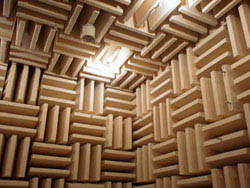Anechoic chamber
|
|
An anechoic chamber is a room that is isolated from external sound or electromagnetic radiation sources, sometimes using sound proofing, and prevents the reflection of wave phenomena (reverberation). Anechoic chambers are widely used for measuring the acoustic properties of acoustic instruments, measuring the transfer functions of electro-acoustic devices, testing microphones and performing psychoacoustics experiments (such as measuring the quality of audio codecs or measuring head-related transfer functions).
Anechoic chambers, modeled after the world's first wedge-based anechoic chamber at Murray Hill, Bell Labs, typically use fiberglass wedges on all walls of the chamber to absorb incoming sound waves. The wedge shape acts as a waveguide to focus incoming sound into the fiberglass wedge, where the acoustic energy is converted to heat. The alternating pattern is used to achieve a more uniform angular absorption. Frequencies below 200 Hz are not as effectively absorbed by the wedges.
Anechoic chambers in which the bottom is also composed of wedges have the floor formed by a wire cage suspended above the bottom by wires. Other anechoic chambers only use wedges for five of the six sides of the room. To prevent external sounds from entering the anechoic chamber, most are encased in a meter or more of cement and may be surrounded by additional insulating materials.
John Cage, a 20th century composer, cited his experience in Harvard University's anechoic chamber in the 1940s — a room in which he expected to hear nothing, but heard instead the sound of his own blood and nervous system — as the inspiration for his famous "silent" composition, 4' 33".
Anechoic chambers for electromagnetic radiation absorption are used in the aerospace industry for radar cross section measurement, among other areas.
External links
- Bell Labs' Murray Hill anechoic chamber (http://www.bell-labs.com/org/1133/Research/Acoustics/AnechoicChamber.html)

